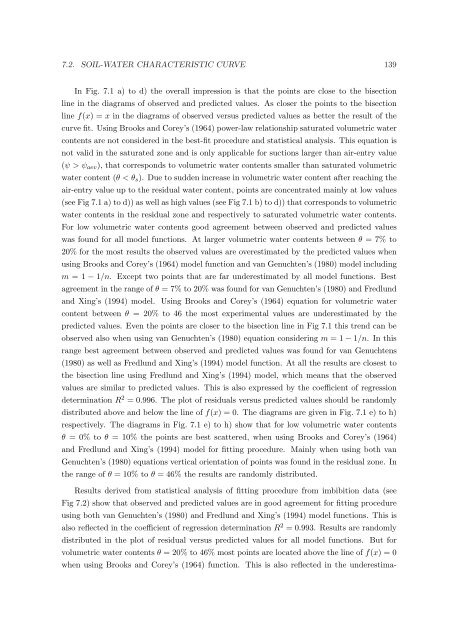Hydro-Mechanical Properties of an Unsaturated Frictional Material
Hydro-Mechanical Properties of an Unsaturated Frictional Material
Hydro-Mechanical Properties of an Unsaturated Frictional Material
Create successful ePaper yourself
Turn your PDF publications into a flip-book with our unique Google optimized e-Paper software.
7.2. SOIL-WATER CHARACTERISTIC CURVE 139<br />
In Fig. 7.1 a) to d) the overall impression is that the points are close to the bisection<br />
line in the diagrams <strong>of</strong> observed <strong>an</strong>d predicted values. As closer the points to the bisection<br />
line f(x) = x in the diagrams <strong>of</strong> observed versus predicted values as better the result <strong>of</strong> the<br />
curve fit. Using Brooks <strong>an</strong>d Corey’s (1964) power-law relationship saturated volumetric water<br />
contents are not considered in the best-fit procedure <strong>an</strong>d statistical <strong>an</strong>alysis. This equation is<br />
not valid in the saturated zone <strong>an</strong>d is only applicable for suctions larger th<strong>an</strong> air-entry value<br />
(ψ > ψaev), that corresponds to volumetric water contents smaller th<strong>an</strong> saturated volumetric<br />
water content (θ < θs). Due to sudden increase in volumetric water content after reaching the<br />
air-entry value up to the residual water content, points are concentrated mainly at low values<br />
(see Fig 7.1 a) to d)) as well as high values (see Fig 7.1 b) to d)) that corresponds to volumetric<br />
water contents in the residual zone <strong>an</strong>d respectively to saturated volumetric water contents.<br />
For low volumetric water contents good agreement between observed <strong>an</strong>d predicted values<br />
was found for all model functions. At larger volumetric water contents between θ = 7% to<br />
20% for the most results the observed values are overestimated by the predicted values when<br />
using Brooks <strong>an</strong>d Corey’s (1964) model function <strong>an</strong>d v<strong>an</strong> Genuchten’s (1980) model including<br />
m = 1 − 1/n. Except two points that are far underestimated by all model functions. Best<br />
agreement in the r<strong>an</strong>ge <strong>of</strong> θ = 7% to 20% was found for v<strong>an</strong> Genuchten’s (1980) <strong>an</strong>d Fredlund<br />
<strong>an</strong>d Xing’s (1994) model. Using Brooks <strong>an</strong>d Corey’s (1964) equation for volumetric water<br />
content between θ = 20% to 46 the most experimental values are underestimated by the<br />
predicted values. Even the points are closer to the bisection line in Fig 7.1 this trend c<strong>an</strong> be<br />
observed also when using v<strong>an</strong> Genuchten’s (1980) equation considering m = 1 − 1/n. In this<br />
r<strong>an</strong>ge best agreement between observed <strong>an</strong>d predicted values was found for v<strong>an</strong> Genuchtens<br />
(1980) as well as Fredlund <strong>an</strong>d Xing’s (1994) model function. At all the results are closest to<br />
the bisection line using Fredlund <strong>an</strong>d Xing’s (1994) model, which me<strong>an</strong>s that the observed<br />
values are similar to predicted values. This is also expressed by the coefficient <strong>of</strong> regression<br />
determination R 2 = 0.996. The plot <strong>of</strong> residuals versus predicted values should be r<strong>an</strong>domly<br />
distributed above <strong>an</strong>d below the line <strong>of</strong> f(x) = 0. The diagrams are given in Fig. 7.1 e) to h)<br />
respectively. The diagrams in Fig. 7.1 e) to h) show that for low volumetric water contents<br />
θ = 0% to θ = 10% the points are best scattered, when using Brooks <strong>an</strong>d Corey’s (1964)<br />
<strong>an</strong>d Fredlund <strong>an</strong>d Xing’s (1994) model for fitting procedure. Mainly when using both v<strong>an</strong><br />
Genuchten’s (1980) equations vertical orientation <strong>of</strong> points was found in the residual zone. In<br />
the r<strong>an</strong>ge <strong>of</strong> θ = 10% to θ = 46% the results are r<strong>an</strong>domly distributed.<br />
Results derived from statistical <strong>an</strong>alysis <strong>of</strong> fitting procedure from imbibition data (see<br />
Fig 7.2) show that observed <strong>an</strong>d predicted values are in good agreement for fitting procedure<br />
using both v<strong>an</strong> Genuchten’s (1980) <strong>an</strong>d Fredlund <strong>an</strong>d Xing’s (1994) model functions. This is<br />
also reflected in the coefficient <strong>of</strong> regression determination R 2 = 0.993. Results are r<strong>an</strong>domly<br />
distributed in the plot <strong>of</strong> residual versus predicted values for all model functions. But for<br />
volumetric water contents θ = 20% to 46% most points are located above the line <strong>of</strong> f(x) = 0<br />
when using Brooks <strong>an</strong>d Corey’s (1964) function. This is also reflected in the underestima-
















